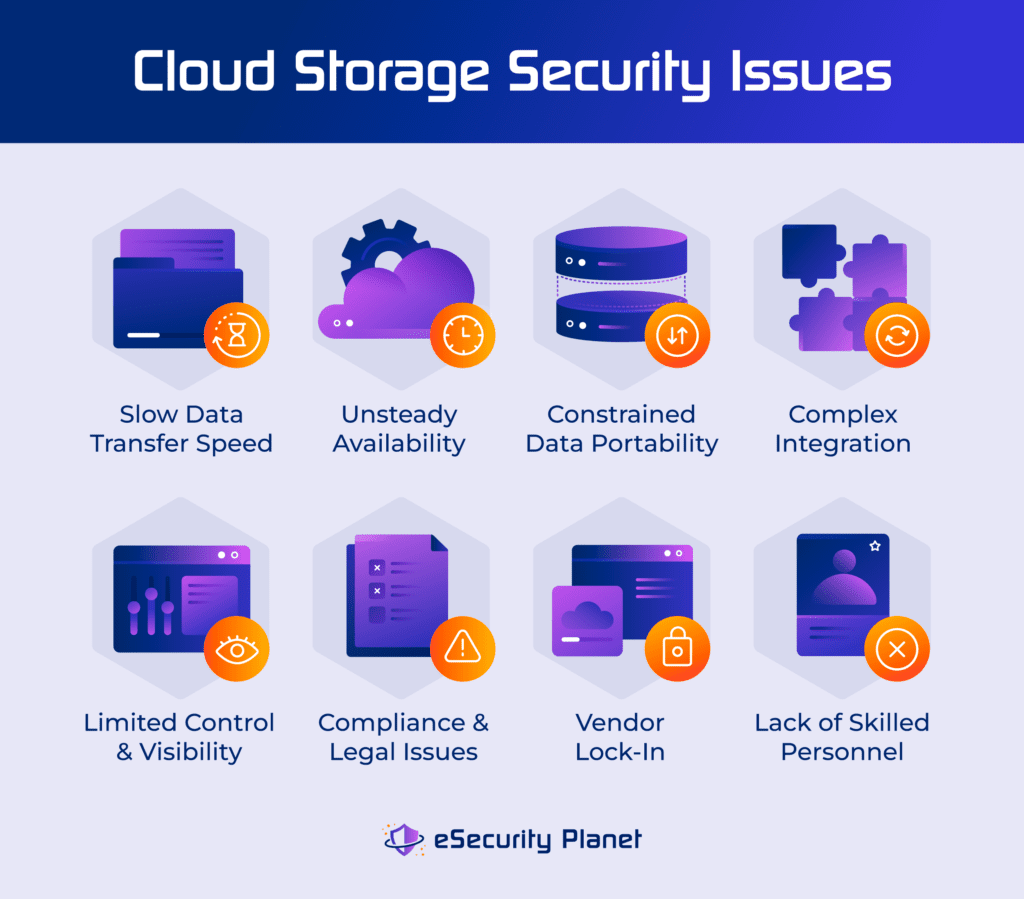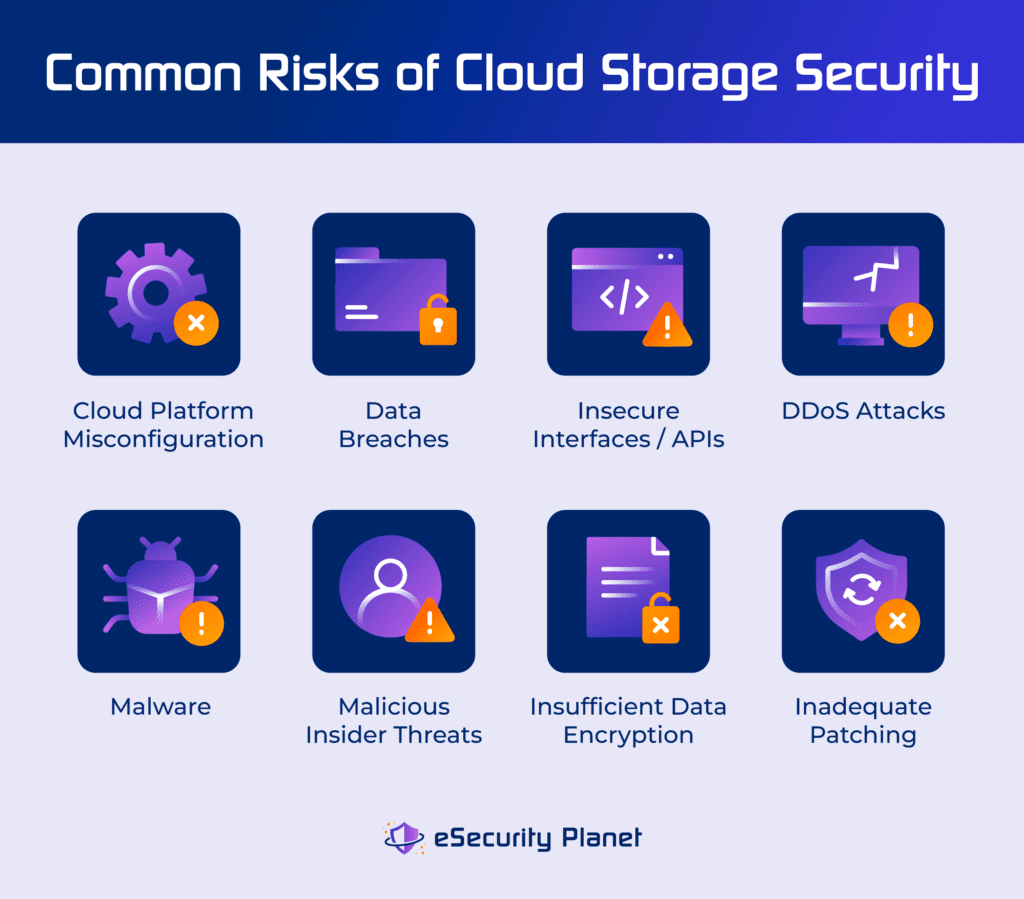Cloud storage security issues refer to the operational and functional challenges that organizations and consumers encounter when storing data in the cloud. The issues stem from internal lapses or deficiencies and may not always include external threats. Cloud storage risks involve potential external threats and vulnerabilities that jeopardize the security of stored data. Risks can lead to issues, but at the same time, you can prevent the risks by addressing these issues.
We’ve identified the top cloud storage security issues and risks, along with their effective mitigation strategies. We’ll illustrate these concepts below with real-life examples of events highlighting vulnerabilities in cloud storage.
Top 8 Cloud Storage Security Issues
Common cloud storage security challenges include data transfer speed, availability and reliability, data portability, integration, and lack of control and visibility. Compliance issues, vendor lock-in concerns, and lack of skilled personnel also pose potential threats to stored data security and functionality.

Data Transfer Speed
Data transfer speeds, or the rate at which data moves between locations, affect the efficient flow of huge datasets, reducing productivity and user satisfaction. As businesses expect immediate data access, slow speed and delays pose dangers, possibly exposing data in transit. Extended delays in transmission allow malicious actors to intercept or compromise data, risking its security and integrity.
To address poor data transmission speeds in cloud storage, optimize network setups, use content delivery networks (CDNs), and implement efficient data compression techniques.
Availability & Reliability
Cloud storage service outages affect business operations and hinder access to crucial data. Downtime limits incident response, increases the risk of data breaches, and can be used as leverage for DDoS attacks.
Implement a strong infrastructure, redundancy mechanisms, and geographically dispersed data centers to reduce downtime. Monitor and employ automated failover to improve resilience while minimizing attack incidents.
Data Portability
Data portability involves transporting data between cloud providers and on-premises systems. Organizations face barriers in seamless migration, which affects flexibility and provider-switching goals. Migration challenges result in incomplete transfers, which expose critical information to risk.
Establish defined protocols and compatibility procedures to ensure a smooth transition between providers and on-premises systems. Regular testing, customization of data transfer methods, and attentive monitoring all contribute to reduce risks and improve security during the migration process.
Integration
Integrating cloud storage with existing on-premises systems or other cloud services can be tricky. Compatibility concerns, data consistency, and established protocol demands contribute to the difficulty of integration. Seamless integrations maintain a fluid workflow and ensure data interoperability.
Use advanced data interoperability solutions, and build clear communication routes between on-premises and cloud systems for workflow efficiency.
Limited Control & Visibility
Insufficient visibility into the cloud architecture causes delays in threat responses, increasing the risk of data breaches. Failure to enforce security regulations and implement appropriate encryption may result in accidental data exposure.
Regular reviews, enhanced analytics, and incident response methods improve security. Use solutions such as Cloud-Native Application Protection Platforms (CNAPP) to reduce risks and speed up response times in the event of a breach.
Compliance & Legal Issues
Regulations and compliance requirements for data storage and processing vary by industry and area. Examples include GDPR in Europe, HIPAA in healthcare, and PCI DSS for payment card data. Failure to meet regulatory requirements can jeopardize data security, subjecting businesses to legal action and reputational harm.
Stay updated on relevant rules and adjust their storage rules accordingly. Implement strong data governance policies, conduct regular compliance audits, and employ cloud services that offer features matched with industry standards.
Vendor Lock-In
Vendor lock-in occurs when an enterprise becomes overly reliant on a single cloud service provider, reducing its flexibility and options. Transitioning away from a supplier can be difficult and expensive. Concerns arise as enterprises desire the option to easily switch providers or implement a multi-cloud strategy to reduce risks and gain a competitive edge.
Using containerization and abstraction layers, such as Kubernetes, guarantees that programs are portable across several cloud environments. Regularly analyzing contractual terms, planning exit strategies, and seeking interoperable solutions help to reduce reliance on a single provider.
Lack of Skilled Personnel
Without qualified personnel, companies may fail to analyze and mitigate security issues. Complicated cloud technologies need specialized expertise for successful adoption and management. Inadequate knowledge of cloud security procedures, configurations, and potential vulnerabilities leads to misconfigurations, insufficient access controls, and overall security weaknesses.
Invest in training and employing qualified individuals. Allowing staff to gain knowledge of cloud security practices, certifications, and specialized platforms broadens their capabilities. Collaborate with external cloud security specialists or managed service providers to enhance internal capabilities.
8 Common Cloud Storage Security Risks & Mitigations
Cloud storage risks include misconfiguration, data breaches, insecure interfaces, DDoS attacks, malware, insider threats, encryption issues, and patching issues. Fortunately, there are mitigation strategies available to address each risk.

Cloud Platform Misconfiguration
Cloud misconfigurations, recognized as the most common vulnerability in NSA research, come from the lack of best practice awareness and insufficient peer review in DevOps/infra teams. Configuration errors can expose sensitive data or services, resulting from incorrectly assigned permissions, unchanged default configurations, and mismanaged security settings. This impacts all users relying on data stored in the misconfigured environments.
Mitigating Cloud Misconfiguration
To effectively manage cloud misconfigurations, here are the five key practices to prioritize:
- Enforce least privilege principle: Keep access privileges to the minimum required for resources. Regularly review and alter user access privileges.
- Use IAM tools: Use third-party tools to scan Identity and Access Management (IAM) policies.
- Review IaC: Ask team members to examine Infrastructure as Code (IaC) files.
- Prioritize HTTPS: Use HTTPS over HTTP and block unneeded ports.
- Centralize secrets and set storage to private: Keep API keys and passwords in a centralized, secure management system. Make the default data storage settings private.
Data Breaches
According to Statista’s data breach report, the US experienced 1,802 breaches, with 422.14 million records exposed. Verizon’s 2023 Data Breach Investigations Report (DBIR) also reveals that inside actors were responsible for 83% of 2022 data breaches. Breaches often stem from exploited vulnerabilities in cloud infrastructure or applications, with hackers using methods such as software vulnerabilities, phishing, or compromised credentials.
Mitigating Data Breaches
Anyone with sensitive data stored in the cloud is vulnerable in the event of a data breach, so adopt the following precautions to lower your risk:
- Encrypt data: Ensure fundamental security by encrypting data in transit and at rest.
- Use API-based CASB: Implement an API-based Cloud Access Security Broker (CASB) to prevent breaches in advance.
- Do regular audits and alerts: Enhance security by conducting regular audits, monitoring activity, and setting up alerts.
- Employ micro-segmentation and JEA: Strengthen user controls with micro-segmentation and Just Enough Administration (JEA).
- Backup files: Regularly back-up public cloud resources.
Insecure Interfaces/APIs
Attackers exploit API weaknesses to gain unauthorized access, manipulate data, and implant malicious code into cloud settings. Users connecting to cloud services via APIs deal with these risks, as do businesses that rely on secure data exchanges. As APIs become more prevalent in modern programming, securing them becomes critical to mitigating typical attack types such as code injection and vulnerability exploitation of access control and outdated components.
Mitigating Insecure Interfaces/APIs
Users with data exposed to potential security concerns due to weak interfaces/APIs can use the following mitigating strategies:
- Implement API security measures: Employ comprehensive API security features, such as regular input data checking and proper authorization protocols.
- Use web application firewall (WAF): WAF screens requests based on IP addresses or HTTP headers, identifies code injection attempts, and defines response quotas.
- Implement DDoS protection: Deploy dedicated protection mechanisms to prevent DDoS attacks.
- Limit rate: Set up rate restriction to limit the number of API queries from a single user or IP address over a given time period.
- Monitor and log API: Establish full monitoring and logging for APIs to track and evaluate actions. Review logs to spot unexpected patterns or potential security incidents.
DDoS Attacks
The average distributed denial of service (DDoS) attack duration increased from 30 minutes in 2021 to 50 minutes in 2022. DDoS attacks are malicious attempts to disable a web service by using vulnerabilities in the network or application layers to interrupt normal operations. It floods cloud systems with traffic, overloading capacity and causing service failures. It impacts CSPs and customers relying on the affected cloud services for data access and storage.
Mitigating DDoS Attacks
To lessen the risk of a DDoS attack, implement the following methods:
- Use traffic filtering: Traffic filtering technologies separate authentic and malicious traffic, allowing the system to reject harmful requests.
- Create redundant network designs: Redundant network structures increase resilience against DDoS attacks.
- Test resilience: Regularly test system resilience using simulated DDoS attacks to find flaws.
- Develop incident response plan: Create and update an incident response plan specifically designed for DDoS attacks.
- Ensure always-on DDoS protection: Ensure that your DDoS protection service is consistently active for extended security.
Malware
There were 5.5 billion malware infections worldwide in 2022. Malware poses a huge threat to cloud storage security when it infects a cloud provider’s systems. As with on-premises systems, attackers can exploit users via malicious email attachments or social media links. Once activated, the malware might evade detection and jeopardize data security by eavesdropping or stealing information from cloud service apps.
Mitigating Malware
Reduce malware threats in cloud storage using these strategies:
- Deploy antivirus solutions: Install antivirus solutions, update them on a regular basis, and monitor cloud environments continuously.
- Back up data: Establish comprehensive backups for speedy recovery in the event of a security incident or data loss.
- Employ network segmentation: Improve security by using network segmentation, which isolates distinct portions to prevent unauthorized access.
- Use multi-factor authentication (MFA): Enable multi-factor authentication to add an extra degree of security by requiring verification beyond passwords.
- Implement zero trust security model: Implement a Zero Trust security model to validate the identity and trustworthiness of people and devices.
Malicious Insider Threats
Malicious insider threats occur when people get illegal access to a company’s resources. These insiders may purposefully abuse their access or accidentally expose critical data through misconfigurations. Insider risks can be attributed to a lack of awareness, employee unhappiness, or social engineering attacks. Malicious insiders may also leverage successful phishing attempts or lax credential security, resulting in unauthorized access to cloud resources.
Mitigating Insider Threats
Use the following measures to mitigate insider threats:
- Perform background checks: Conduct thorough background checks during the hiring process to verify the trustworthiness of new employees.
- Set stringent access controls: Set strict access controls to limit user permissions and prevent illegal access.
- Continue training staff: Provide personnel with ongoing cybersecurity training to raise awareness and advocate secure practices.
- Apply safe password practices: Ensure strong user authentication, use MFA, and follow safe password practices.
- Filter phishing emails: Employ an automated method to filter out phishing emails and lower the danger of employees being victims of phishing assaults.
Insufficient Data Encryption
Insufficient data encryption in cloud storage happens when information is not properly protected during storage or transport, making it exposed to unwanted access. This lack of encryption creates substantial dangers, such as unauthorized access, interception during data transfer, breach of confidentiality, data tampering, and compliance violations.
Mitigating Insufficient Data Encryption
These strategies against insufficient data encryption should be implemented by both cloud service providers and the organizations or users utilizing cloud services:
- Use end-to-end encryption: End-to-end encryption technologies protect data throughout the communication process.
- Encrypt data-in-transit and at-rest: Apply encryption technologies to protect information during transmission and storage.
- Update encryption standards: Stay updated on the latest encryption standards and technologies to ensure the implementation of strong security measures.
- Adopt access controls: A strong access control prevents unauthorized access to sensitive information.
- Conduct regular audits: Regular audits of encryption practices detect and address potential vulnerabilities early on.
Inadequate Security Patching
Inadequate security patching is the delayed or incomplete installation of required security fixes to a system or program. When security patches are not applied on time, the system remains vulnerable to cyberattacks. Malicious actors frequently target known software vulnerabilities, using the delay in patch installation to gain unauthorized access or jeopardize the security of the cloud environment.
Mitigating Inadequate Security Patching
Users relying on cloud services to ensure a secure and resilient cloud environment may do the following to address inadequate security patching:
- Implement patch management system: A solid patch management system automates the identification, testing, and rapid deployment of security patches.
- Perform regular vulnerability scanning: Do regular vulnerability scans to discover potential security flaws and prioritize patching based on critical vulnerabilities.
- Create patching policies: Enforce clear patching policies that specify deadlines and methods for installing security patches throughout the cloud infrastructure.
- Communicate with vendors: Maintain communication with software providers to know the latest security patches and updates, ensuring timely installation.
- Create segmented network architecture: A segmented network design reduces patching impact and allows isolated upgrades without disrupting the overall system.
Examples of Real Cloud Storage Vulnerabilities Exploited
Some of the biggest instances of cloud storage vulnerabilities that happened in the last five years include Cam4’s largest data breach incident, MEGA’s critical security issues, and LastPass’ malicious insider threats. Read on to learn more about each vulnerability and how these organizations addressed it.
Cam4’s Misconfiguration & Data Breach (2020)
Cam4 holds the record for the greatest data breach of all time, with 10 billion compromised accounts. In early 2020, researchers uncovered a large data breach from adult site CAM4 caused by a misconfigured Elasticsearch database. The theft revealed 11 billion records, including sensitive user information such as names, emails, passwords, and payment details.
Fortunately, Safety Detectives, a security firm, discovered the compromised database before the cybercriminals. Granity Entertainment, CAM4’s parent business, quickly took the database down. While there’s no proof of stolen user information, the incident underlines the dangers of blackmail, sextortion, and credential stuffing assaults. CAM4 responded by protecting the server and eliminating personally identifiable information, lessening the impact of the breach.
MEGA’s Critical Vulnerabilities Attacks (2022)
In 2022, ETH Zurich researchers discovered critical security flaws in the MEGA cloud storage service that jeopardized user data confidentiality. With over 10 million daily users and 122 billion files shared, MEGA, recognized for user-controlled end-to-end encryption, was at risk of privacy breaches and unwanted data access. The attacks included plaintext and framing attacks, integrity attacks, and a Bleichenbacher-style RSA encryption attack.
MEGA responded with software updates to fix critical vulnerabilities, attempting to improve the security of its cryptographic architecture. By the end of 2022, they had fixed all vulnerabilities in the webclient and in the native apps.
LastPass’ Insider Threat (2023)
LastPass announced a security incident in February 2023 where a senior engineer with special access to LastPass’ critical systems had his home computer hijacked, resulting in the theft of authentication credentials. Exploiting these credentials, the attackers got access to LastPass’ Amazon S3 cloud storage, compromising production backups, other cloud resources, and important database backups.
Following the hack, LastPass increased security safeguards on its AWS S3 storage, including improved logging, alerting, and tighter IAM controls. They deactivated previous development IAM users, enforced limits on long-lived IAM users, rotated production service IAM user keys, imposed severe IP restrictions, eliminated obsolete IAM users, and implemented IAM resource tagging enforcement with periodic non-compliance reporting.
Bottom Line: Mitigate Cloud Storage Security Issues & Risks
Addressing cloud storage risks guarantees data integrity and protection against unauthorized access, breaches, and compliance violations. Implementing strong security measures, such as encryption, training, and regular audits, is fundamental to shield businesses against financial losses, reputational harm, and legal ramifications of compromised data and privacy breaches.
For a better defense against these vulnerabilities, learn the cloud security best practices and tips to ensure the overall security of your data stored in the cloud.




